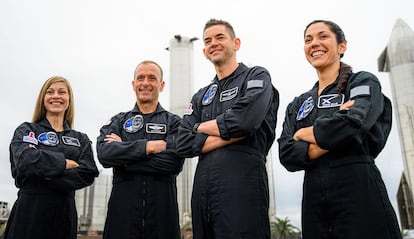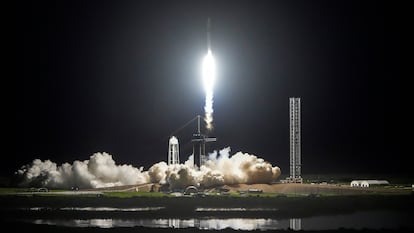SpaceX’s ‘Polaris Dawn’ mission launches
The unprecedented space flight will carry four non-government agency crew members, including billionaire Jared Isaacman, into high Earth orbit and across areas with high radiation risks
SpaceX has successfully launched the Polaris Dawn mission from the Kennedy Space Center at Cape Canaveral in Florida. The launch was initially scheduled for August 27, but after two weeks of postponements — due first to a helium leak and then to adverse weather conditions — this innovative five-day spaceflight lifted off smoothly Tuesday and entered orbit about 12 minutes later, when the upper stage of a Falcon 9 rocket gave it a final boost and separated from the Crew Dragon capsule. Aboard the craft, four astronauts will seek to break several space records that have stood since the first space race more than half a century ago.
In the current reconquest of space the limits are no longer sought exclusively by government agencies such as NASA, but also by billionaires in the technology sector seeking to put private missions such as this one ahead of the curve, and even to place themselves at the controls of the spacecraft.
Jared Isaacman, founder and president of the payment processing company Shift4, is the commander of the five-day manned space flight that kicks off the Polaris program, financed by Isaacman and operated by Elon Musk’s SpaceX. The mission aims to achieve two major milestones in the new space race: to carry out the first private spacewalk in history — without the participation of astronauts from a public agency — something the crew will attempt Thursday, and to take a manned flight as far as anyone has gone since the end of the Apollo lunar exploration program in 1972.
Since then, all manned missions into space have remained at the most in low Earth orbit, where the International Space Station (ISS) — which orbits at an average altitude of 420 kilometers (260 miles) above the Earth’s surface — is positioned. As part of its first day of flight, Polaris Dawn will aim to reach a maximum altitude of 1,400 kilometers (870 miles). If successful, it would beat the record set by NASA’s Gemini 11 spacecraft, which in 1966 orbited at a maximum altitude of 1,373 kilometers (853 miles). Only the astronauts of the Apollo missions have been further, not orbiting around the Earth, but launched on a trajectory towards the Moon, which is at an average distance of 384,400 kilometers (238,855 miles) from our planet.
SpaceX’s Crew Dragon spacecraft carrying the four Polaris Dawn mission crew members — in addition to Isaacman, retired U.S. Air Force pilot Scott Poteet and two SpaceX employees, mission specialists Sarah Gillis and Anna Menon, are aboard — was inserted into a highly elliptical orbit around the Earth: it passes its closest point to our planet’s surface at an altitude of 190 kilometers (118 miles) and moves away, at its apogee, at up to 1,200 kilometers (745 miles). If the Polaris Dawn mission succeeds, Gillis and Menon will become the highest-flying women in history, beating NASA astronaut Kathryn Sullivan’s record of 621 kilometers (389 miles).
If all goes according to plan, after eight circuits around the Earth in that initial orbit, the Crew Dragon capsule will begin to climb to an analogous orbit but with a maximum of 1,400 kilometers (870 miles). After six more orbits, reaching that record orbital altitude for astronauts, the spacecraft will descend Wednesday to an orbit with a maximum altitude of 700 kilometers (435 miles). At that altitude, preparations will continue for the mission’s next milestone: Thursday’s first private spacewalk in the history of astronautics.

The risks of space radiation
Although preparations for the historic spacewalk began after launch — some 48 hours of decompression are required — the astronauts’ main occupation during the first day of the mission will be to study the effects of space radiation on the human body. In the higher reaches of its trajectory, the SpaceX spacecraft will enter areas of the inner Van Allen radiation belt, which marks the boundary of low-Earth orbit. The mission plan includes nearly 40 experiments aimed at assessing the health risks to astronauts of operating in these conditions, which will be crucial for future long-duration missions to return to the Moon over the next decade, as the first stop on a more ambitious goal of eventually reaching Mars with manned expeditions.
After about 10 hours in orbit, reaching that maximum of 1,400 kilometers, the spacecraft will decrease its altitude and preparations will continue for the highlight of the mission: the spacewalk planned for the third day of the flight. When the Crew Dragon capsule hatch opens, the entire crew will experience the complete vacuum of floating in open space, something that very few current astronauts achieve. Isaacman and Gillis will then perform a spacewalk: only astronauts from NASA, the ESA, and the Russian, Canadian, Chinese and Japanese space agencies have previously been outside a spacecraft.
SpaceX has developed a new spacesuit for the mission, which can be used both for extravehicular activities and inside the spacecraft from launch to landing. The current standard for manned missions is to have a different spacesuit for operating inside and outside the spacecraft. SpaceX’s new suit is reminiscent of the early space age, as it has an umbilical cord that connects it to the spacecraft and not a self-contained life support case like the suits used in spacewalks from the shuttles and the International Space Station.
Once the principal objectives of the Polaris Dawn mission have been completed, the astronauts will spend the fourth day to carrying out further experiments, as well as photographs and observations of the Earth. On the fifth and final day, the spacecraft will begin its descent and re-entry into the Earth’s atmosphere, with a splashdown in the Atlantic Ocean off the coast of Florida, as is the case with the regular flights made by Crew Dragon craft, which include bringing astronauts back from the ISS every six months.
Sign up for our weekly newsletter to get more English-language news coverage from EL PAÍS USA Edition
Tu suscripción se está usando en otro dispositivo
¿Quieres añadir otro usuario a tu suscripción?
Si continúas leyendo en este dispositivo, no se podrá leer en el otro.
FlechaTu suscripción se está usando en otro dispositivo y solo puedes acceder a EL PAÍS desde un dispositivo a la vez.
Si quieres compartir tu cuenta, cambia tu suscripción a la modalidad Premium, así podrás añadir otro usuario. Cada uno accederá con su propia cuenta de email, lo que os permitirá personalizar vuestra experiencia en EL PAÍS.
¿Tienes una suscripción de empresa? Accede aquí para contratar más cuentas.
En el caso de no saber quién está usando tu cuenta, te recomendamos cambiar tu contraseña aquí.
Si decides continuar compartiendo tu cuenta, este mensaje se mostrará en tu dispositivo y en el de la otra persona que está usando tu cuenta de forma indefinida, afectando a tu experiencia de lectura. Puedes consultar aquí los términos y condiciones de la suscripción digital.
More information
Archived In
Últimas noticias
Most viewed
- Sinaloa Cartel war is taking its toll on Los Chapitos
- Reinhard Genzel, Nobel laureate in physics: ‘One-minute videos will never give you the truth’
- Oona Chaplin: ‘I told James Cameron that I was living in a treehouse and starting a permaculture project with a friend’
- Why the price of coffee has skyrocketed: from Brazilian plantations to specialty coffee houses
- David King, chemist: ‘There are scientists studying how to cool the planet; nobody should stop these experiments from happening’












































